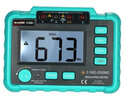I use a clamp on ammeter to measure the earth leakage, seen here showing 8 mA, the accepted limit for a RCD is 1/3 of the RCD rating, so 9 mA is the limit. I actually have 14 RCBO's so well within the limit, but the problem in the past has been when RCD's were fitted often no one tested back ground leakage.
So standard test for RCD is it will trip at rated current and will not trip at ½ rated current which is far enough if latter tested with all circuits turned on, as with a 30 mA RCD that means one has a 15 mA leeway, so likely the same as testing leakage below 9 mA, however often they were tested with all MCB's off, so all a bit hit and miss as to how much extra leakage will cause a trip.
Today we would normally use RCBO's which is a MCB and RCD combined, main reason is so less will trip with a fault, one could replace the RCD with an isolator then fit RCBO's on everything supplied by that isolator, or one can hunt for the fault.
The meter normally used to find the fault

used DC at 500 volt. This will locate faults, but because it uses DC it will not show back ground leakage, the inductive and capacitive linking in the cables means there is always some leakage. And this will vary home to home, so one person may find the two RCD's are fine, others they trip all too frequent.
My old house had two very old RCD's fitted in the 90's when son decided to become a radio amateur, and I found over the years I would get a bout of tripping, it may trip 4 times in a week, then no change made and go for 2 years before next trip. I blamed spikes on the supply, but no way of proving this, however resetting one, could cause the other one to trip, in theroy that should not happen, so it seems reasonable to consider spikes can cause the old units to trip.
New units use electronics, but spikes can damage electronics, so a surge protection device (SPD) is really required to protect the RCD's.
So we start to reach the point where it seems prudent to swap whole consumer unit (CU) and go steel with all RCBO's.
The old idea was to split the house side to side, this reduced the loop impedance, and spread out the load better, and reduced the need to run extension leads up/down stairs, which is a temptation when one has a unknown fault tripping one RCD, however there was a problem, the idea is not to have lights and sockets on same RCD as if you do some thing to give you a shock and trip the RCD last thing you want is to also be plunged into darkness, and to split lights side to side was not easy, so there was a move to splitting up/down for sockets as well. Today with RCBO's we can return to side to side split.
As to the fault in question it has already been dealt with however the comment
I've just eyeballed and felt around the external 2-way socket. It's in a plastic box attached to the wall, there's a bead of silicone around it,
is flawed, as it means any water which does get in, can't get out again, often better to have a small hole in the bottom, often the sealing bead has a small space at bottom so any water can leave. The problem is when the weather is warm air inside the box expands, and then when it rains it cools so effectively sucking in water. It is the vary fact that some one has tried to seal it, that causes the problem.
Outside lights are the worst, as there is a tendency to mount the PIR under the lamp, so any water which does get in, drains down into the PIR and causes problems, rare to find drain holes in PIR's.


